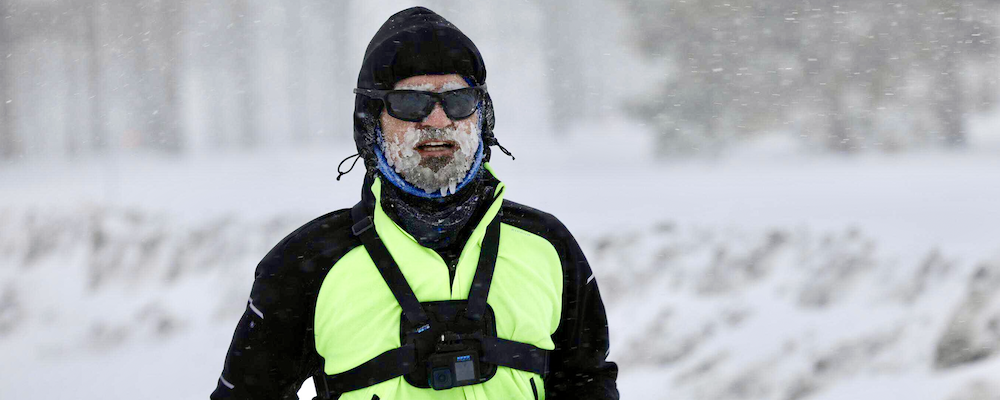Overall rating: 7/10 see why at the end of the report | comparison of all my races
When you decide to live in Eastern Ontario, you made your peace with winter running, and even start enjoying it at some point. I’ve lived in Ottawa for more than six years now and got used to running in cold, snowy weather between December and April. This marathon, though, happened to take place in the middle of this region’s heaviest blizzard in decades and turned out to become one of my most memorable race experiences.
Tough conditions!
The first time I ran this marathon was in 2022 (see race report), and I knew what to expect: a well-organized event, courtesy of our local multi-sport racing series, Somersault — and a relatively cold day to go with it. This year didn’t disappoint. Winter had been relentless, with double-digit negative temperatures since late December and fresh snowfall just days before race day. To top it off, a blizzard was in the forecast for the morning. Ten years ago, this would have been bad news for me. Today? Just another challenge to embrace. When marathons start feeling like an endurance routine, you begin to welcome the tougher conditions—after all, it’s the races that make you suffer that stick with you the longest.
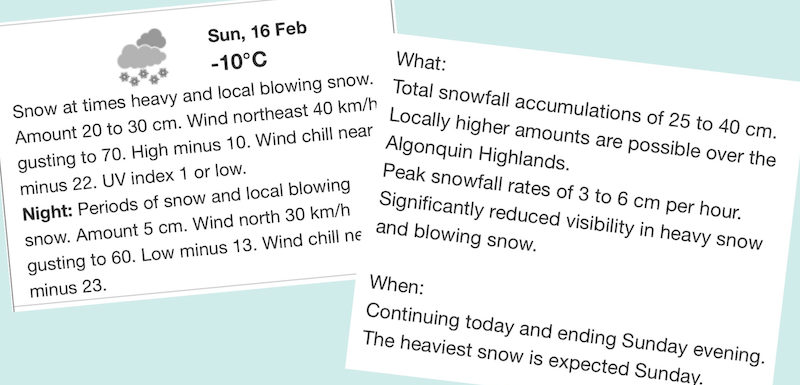
Local events are the best
One of the perks of running local races is that your morning routine stays blissfully unchanged. In this case, the starting line was just a short bike ride from home. After an early Sunday breakfast, I hopped on my commuter bike and made my way through strong winds and unplowed sidewalks toward the Canadian War Museum — the race venue and, more importantly, a warm indoor refuge. Few things are as appreciated on a day like this as heated washrooms, space to stash dry clothes, and a place to defrost before the start.
With about 30 minutes to spare, I went through my now well-practiced cold-weather marathon ritual: slathering my exposed skin with Vaseline, securing my bib number to my race belt, swallowing a banana, downing 500ml of electrolytes, and layering up with an assortment of scarves, hats, and hoodies until I looked like a heavily bundled-up explorer rather than a runner. Finally, I checked my GoPro — this would be my first attempt at filming a long-distance race. Because if you’re going to suffer through a blizzard for 42.2 kilometers, you might as well have video evidence.
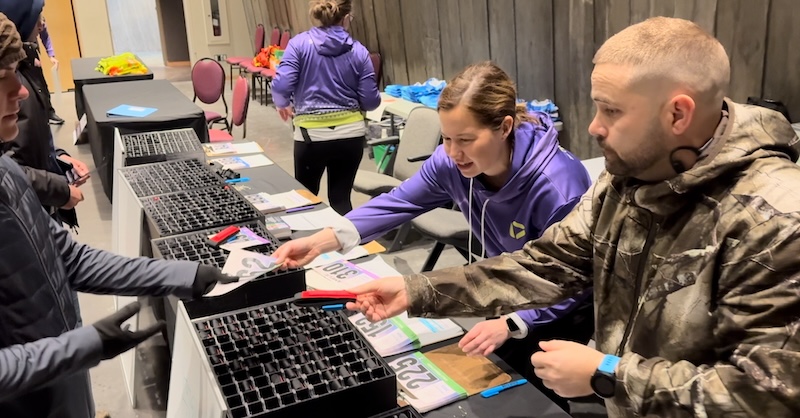
Out of the 100+ registered athletes, only 35 of us actually showed up — thanks, weather forecast. But for some, the harsh conditions weren’t a deterrent; they were the main attraction. I chatted with a seasoned runner from Connecticut who had come all the way to Ottawa specifically to experience a snowy, frigid marathon. He definitely got his money’s worth.
The course
I’m usually not a big fan of multi-loop courses. Running the same stretch of road over and over can feel a bit like being trapped in a marathon-themed Groundhog Day. But for an event like this, the format made perfect sense. In freezing temperatures with heavy snowfall, you don’t want a small pack of runners scattered across a massive distance. An eight-loop course meant easier logistics: fewer volunteers needed for water stations, less effort securing the route, and minimal disruption to traffic and snow removal. Plus, in conditions like these, it’s reassuring to know you’re never too far from warmth — or, at the very least, from someone who can call for help if you turn into an ice sculpture mid-race.
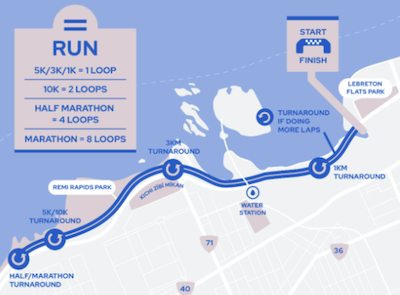
(map from somersault.ca)
The starting line was just a short walk from the museum, set on Kichi Zibi Mikan. The course began with a quick climb up a short hill before following the parkway along the Ottawa River, leading to a turnaround point 2.5 kilometers in. Then, after another 12 minutes, it was back up the hill again to complete the loop. Repeat eight times, and voilà — a marathon. A single hydration station stood along the course, manned by a group of brave volunteers handing out water, electrolyte drinks, and Xact bars—because nothing says “winter racing” like trying to chew a frozen energy bar while running into a headwind.
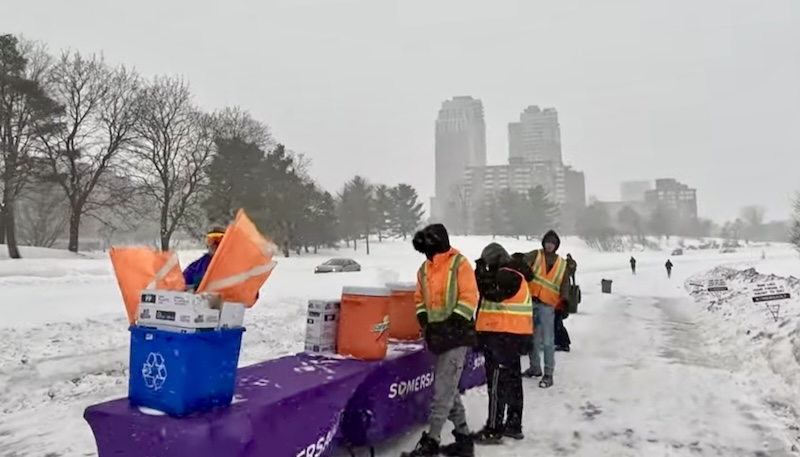
The first 10k
The snow storm was in full swing when all 35 runners gathered at the starting line just minutes before 8am. Race director Adam provided some final instructions while everyone seemed to be eager to start running and fighting the freezing temperatures. Right on top of the hour we were let go onto our individual journeys over the next 42.2 kilometers.
A tailwind was blowing strongly from an easterly direction, pushing us westwards, and making the first miles feel rather easy. My body warmed up quickly, up to the point that I even felt overdressed. I was in a good mood, as always, when a race finally starts. All the self-doubts and race anxieties are washed away as soon as you cross the starting line. Now, everything is just about the moment and figuring out your rhythm. For the first marathon of the season, my goal was basically just finishing while having fun as long as possible. I’ve done quite a bit of running in harsh conditions, but today’s blizzard was predicted to worsen over the morning hours – any competitive race goal for me was out of question. And it became clear relatively quickly, that the snow-covered road would make the footing extra sketchy, requiring much more effort for every single step.
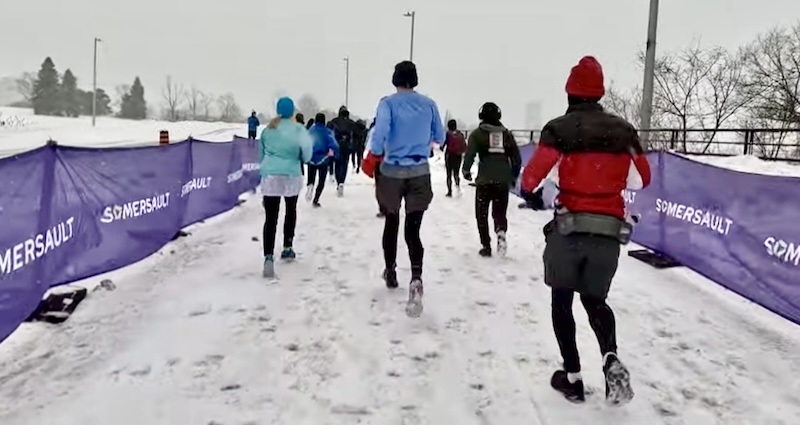
Just after the first turnaround at 3 kilometers, reality hit me like an icy slap to the face—literally. The headwind, which had been lying in wait, wasted no time draining my warmth and momentum. On the bright side, my energy was still up, and I decided to frame this sudden spike in suffering as a “fun challenge.” After all, there was another turnaround in just 15 minutes. That’s what I kept telling myself, anyway.
Then came the hill. Not a mountain by any means, but still the kind of incline that makes you question your life choices—especially when paired with a snowstorm and footing that felt like running on a half-melted Slurpee. I remembered it well from the last two years’ half marathons, though back then, I only had to endure it once. The thought of climbing it seven more times today sounded almost like an impossible feat at this time.
Reaching the top was a relief, if only because it meant I wasn’t stuck on that hill forever. A couple hundred meters ahead, I spotted the next turnaround, and to my surprise, a small group of spectators had gathered. These brave souls stood behind the cones, cheering for each frozen, wind-battered runner who passed. A welcome distraction for me on an otherwise rather quiet course. Then again, watching 35 slightly unhinged marathoners voluntarily run through a snowstorm provided its own form of entertainment. Hats off to all of them, for making some questionable decisions that day!
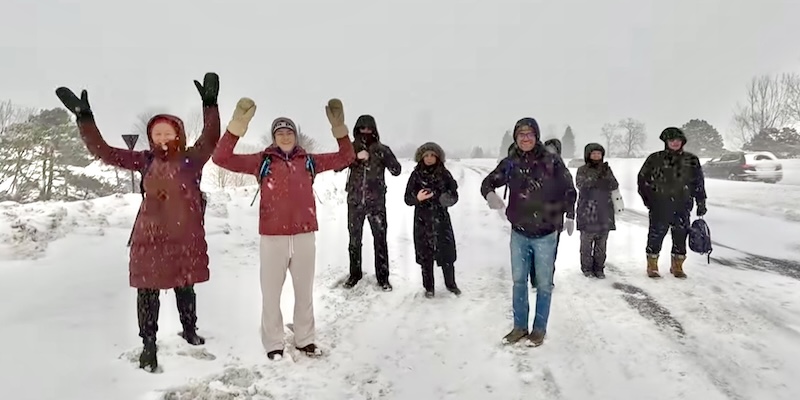
After grabbing a few quick sips of electrolytes at the water station near the bottom of the hill, I settled back into a steady pace — around 5 minutes per kilometer. So far, so good. The second loop still felt manageable, though the footing was already starting to degrade, transforming from “lightly packed snow” to something closer to a very poorly maintained ice rink. To keep my mind occupied, I filmed parts of the course, some of the other runners, and myself — offering semi-insightful reflections like, “Well, this is getting worse.”
Mid-race: harder than expected
And getting worse it was. More snow kept piling up, burying the few patches of exposed asphalt that had briefly given me hope. Every step turned into a game of slip-and-slide, and the constant shifting started to wear on my feet—blisters forming on my big toe well before the halfway mark. Meanwhile, the ice shield on my face kept growing, which, on the bright side, was at least serving as a natural wind barrier. The rest of my body, however, was not so lucky. The creeping cold set in, and the thought of enduring another two hours of this delightful combination of exhaustion, pain, and borderline hypothermia was, frankly, terrifying.
This wasn’t my first rodeo. I had 22 marathons under my belt, most of them in recent years, and if there’s one thing long-distance running has taught me, it’s this: Just because something feels awful now doesn’t mean it will still feel awful in 10 minutes. Discomfort is unpredictable. Sometimes it fades, sometimes it shifts into a different (and hopefully lesser) form of misery, and sometimes — just to keep things interesting — it sticks around like an uninvited guest. The trick is to focus on the immediate: the next 500 meters, the next turnaround, the next hill. Before you know it, the worst pain might be gone — or at least replaced by something new and slightly less unbearable.
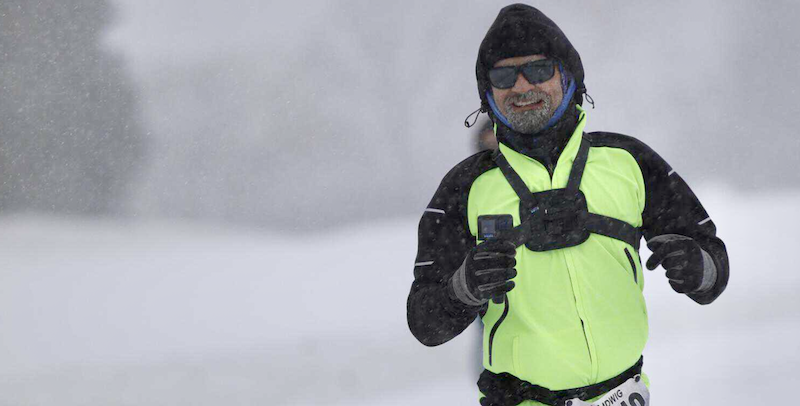
That said, I had to admit: today’s conditions were among the toughest I’d ever faced, as expected. By the 20-kilometer mark, my pace had taken a noticeable hit, and I started measuring the race in loops rather than kilometers—each one ending with that relentless hill, which had long since worn out its welcome. For a while the course grew busier as half-marathoners and 10K runners joined in, and thanks to the out-and-back design, I regularly saw familiar faces heading the opposite way. There’s something uplifting about exchanging high-fives with friends who are battling through the same blizzard. Misery may love company, but in races like this, it also loves a good, frozen-fingered fist bump.
Finishing project blizzard marathon
Loop after loop, I inched closer to wrapping up this frosty adventure. Each time I reached the lone water station, I slowed down just enough to grab a cup or two — always first checking that its contents were still in liquid form. Drinking in these conditions was an ordeal of its own. My facial muscles had lost most of their mobility, turning every sip into an awkward exercise in coordination. Meanwhile, my beard was evolving into a full-on icicle farm—part sweat, part snow, part electrolyte-drink runoff. A true winter endurance aesthetic.
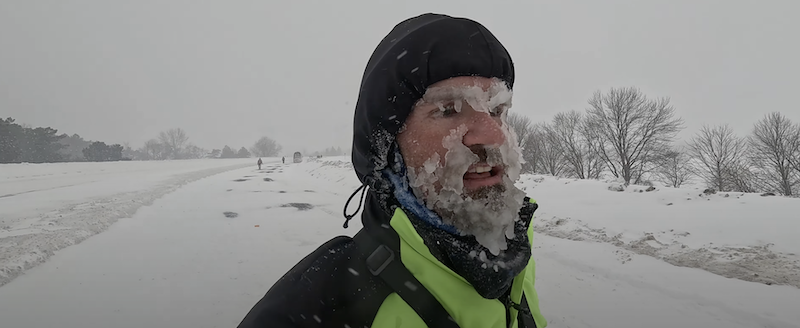
By the final loops, my face was completely encased in ice. It certainly was a funny sensation, but it wasn’t until I saw myself afterward that I realized just how absurdly epic I looked — somewhere between a grizzled Arctic explorer and a man who had lost a bet with Mother Nature.
The storm had intensified, and the road was now more of a suggestion than a surface to run on. But when I hit that brutal hill for the eighth and final time, it felt… weirdly great. I glanced at my Garmin — if I held my pace, I could just slip under four hours. That was all the motivation I needed. With a final push, I crossed the finish line in 3:59:43. Marathon number 23: complete. And this one? Definitely one for the books.
Project Blizzard Marathon was accomplished. First in my age group (out of a highly competitive field of three), and seventh overall. Not bad for a guy who spent half the race turning into an ice sculpture.
Aftermath
- Second winter marathon, and the second time in very challenging conditions
(after Winterman 2022) - Somersault runs are perfectly organized yet local events every athlete in the region should check out. Thanks Adam for putting so much effort into it!
- My nutrition game is getting much better. In 2022 I learned, that bringing along hydration on a run at -15ºC or colder does not make sense. I stuck to on-course nutrition only, drinking electrolytes regularly and eating three Xact bars.
- Running in challenging conditions is unbelievably rewarding and give you an even higher sense of accomplishment than a ‘regular’ marathon.
- Next up: Kulturhauptstadt-Marathon in my German hometown of Chemnitz, in about 12 weeks!
Stats
Total distance: 42.2km
Total time: 3h59m (compared to 3h04m personal best)
Average HR: 160bpm
Total elevation: 300m
Calories burned: 3000
Calories consumed: 300
Fluids consumed: 900ml
Temperature: -10ºC (-20ºC windchill)
Total number of registered runners: 560 (35 of which were marathoners)
Somersault Embrace Winter Marathon Ottawa, ON, Canada | |||
Overall rating | |||
 | 2025 |  | 35 |
 | Winter |  | 8 loops |
 | 8:00AM |  | Rolling (250m) |
 | -15ºC |  | Snow |
Individual ratings* | |||
Spectators | Scenery & views | ||
On-course nutrition | Overall organization | ||
Medal design | Finisher shirt | ||
Timing and splits | Value | ||
What stood out Crazy weather this year (blizzard). Very well organized and the volunteers are tough for being there! No timing mats at the turnarounds, so no splits available. | |||
*Individual ratings: details see below
Note that those ratings are highly subjective and only based on the last time I personally ran that particular race. Some things like medal or finisher shirt design can highly fluctuate from year to year. Please feel free to leave a comment or contact me for any more details.
Spectators: How many spectators along the course? How much action and welcome mental distraction for runners, especially during the second half of the course was offered? Higher ratings for more spectators, action, music, etc.
On-course nutrition: Number of water stations and variety of nutrition offered.
Medal design: Important aspects for me: Does the medal to some extent resemble the location or the course? Does it show the distance and date of the event? Does it have a reasonable size and shape? How creative is the design? Does it look cheap?
Timing and splits: How many timing mats were on the course? Were there timing mats in key areas to prevent shortcuts and to provide timing splits?
Scenery/views: How much visual distraction and awe do you get as a runner along the course. Usually one-loop or point-to-point races provide more variety than multi-loop courses. I value natural scenery higher than industrial or suburban areas.
Overall organization: How well was the whole event organized; including communication before and after the event, available course information, expo, additional events, pre- and post-race announcers, start and finish line area design, etc.
Finisher shirt: Design of the shirt, the type of fabric, is it full of sponsors?
Value: What you get vs what you paid. Some races are super expensive and you don’t even get a shirt, others are reasonably priced and even include a pasta party the day before. High ratings either mean cheap entry or lots of goodies.

